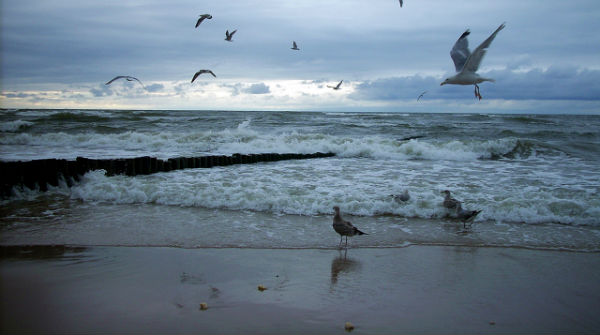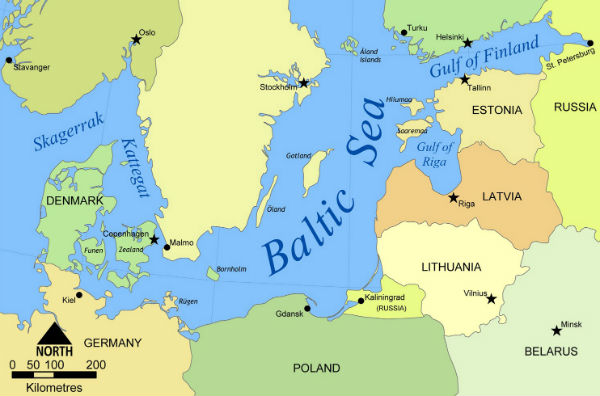Saving the Baltic Sea

The Baltic Sea, the largest body of brackish water (brackish water is slightly salty water) on Earth, was considered healthy as late as the 1950s. Since then, the Baltic’s health has seriously deteriorated due to waste from expanding industry and large urban areas, fertilizers used in agriculture, and the development of wetland areas. The fishing and recreation industries have already been affected by the pollution in the Baltic, and action was needed to prevent permanent damage. The waste includes industrial emissions, agricultural runoff (fertilizers), urban pollution, untreated sewage, wastewater from pulp-and-paper and other industries, toxic substances and heavy metals. Many different species are threatened in the Baltic Sea, but the most often mentioned are herring, salmon, and cod (see UKCOD case).
An average of 60,000 km2 of the Baltic Sea bottom has suffered from hypoxia without enough oxygen to support its normal ecosystem over the last decade. Researchers warn of the unforeseen effects of geo-engineering to relieve the lack of oxygen in bottom waters.
“Such radical remediation measures promise impressive improvements in water quality on short time scales. They are popular and politically attractive, but they are also potentially dangerous!” Daniel Conley, a researcher at Lund University
Several large-scale geo-engineering interventions are currently proposed as possible solutions to this problem. Researchers from Lund University are calling for geo-engineering efforts that mix oxygen into the Deep Baltic to be abandoned. The Swedish Agency for Marine and Water Management has announced a plan to build a demonstration wind-turbine-driven pump in the southern Baltic. This is a significant change in current policy to reduce nutrients to the Baltic Sea.
“Countries from around the Baltic Sea must immediately implement the national reductions for nutrients that have been agreed upon in the Baltic Sea Action Plan. If actions are postponed further, the situation in the Baltic Sea will continue to worsen.” Daniel Conley
According to the The Fifth Baltic Sea Pollution Load Compilation (PLC-5) report from February 2012, agriculture continues to be the main diffuse source of nitrogen and phosphorus inputs into the Baltic Sea. Nutrient losses from anthropogenic diffuse sources accounted for about 45 per cent of the total reported phosphorus and nitrogen loads into the Baltic Sea and of this, the share emanating from agriculture was about 70 – 90 per cent for nitrogen and 60 – 80 per cent for phosphorus. Based on the PLC-5 data, it is estimated that waterborne inputs of nutrients to the Baltic Sea amounted to 638,000 tonnes of nitrogen and 28,400 tonnes of phosphorus in 2006. About 5 per cent of the nitrogen load originated from point sources discharging directly into the Baltic Sea, while the rest was transported via rivers. For phosphorus the contribution from these sources was higher, about 8 per cent.

The Baltic Sea is connected by man-made waterways to the White Sea via the White Sea Canal, and to the North Sea via the Kiel Canal. The Baltic Sea might be considered to be bordered on its northern edge by the Gulf of Bothnia, on its northeastern edge by the Gulf of Finland, and on its eastern edge by the Gulf of Riga. The Baltic Sea is about 1,600 km (1,000 miles) long, an average of 193 km (120 miles) wide, and an average of 55 m (180 feet) deep. The maximum depth is 459 m (1506 feet) which is on the Swedish side of the center. The surface area is about 377,000 km² (145,522 sq miles) and the volume is about 20,000 km³ (5040 cubic miles). The periphery amounts to about 8,000 km (5,000 miles) of coastline.
For more information contact:
Daniel Conley, Department of Geology, Lund University
Tel. +46 (0)70 – 749 43 41, daniel.conley@geol.lu.se
Johanna Stadmark, Department of Geology, Lund University
Tel. +46 (0)70 – 364 04 39, johanna.stadmark@geol.lu.se
The Baltic Sea Action Plan
The Fifth Baltic Sea Pollution Load Compilation (PLC-5)
Source: TerraDaily, Lund University, Helcom

Commenting rules and guidelines
We value the thoughts and opinions of our readers and welcome healthy discussions on our website. In order to maintain a respectful and positive community, we ask that all commenters follow these rules:
We reserve the right to remove any comments that violate these rules. By commenting on our website, you agree to abide by these guidelines. Thank you for helping to create a positive and welcoming environment for all.